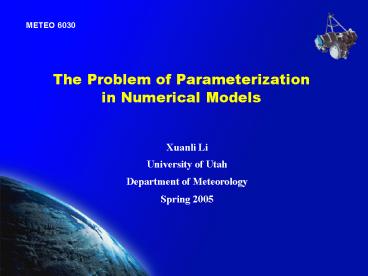The Problem of Parameterization in Numerical Models - PowerPoint PPT Presentation
1 / 14
Title:
The Problem of Parameterization in Numerical Models
Description:
Arakawa Schubert scheme. Betts Miller scheme. Kuo scheme. ... 4 Arakawa Schubert scheme. Complex scheme from Arakawa and Schubert 1974. Basic idea: ... – PowerPoint PPT presentation
Number of Views:51
Avg rating:3.0/5.0
Title: The Problem of Parameterization in Numerical Models
1
The Problem of Parameterization in Numerical
Models
METEO 6030
Xuanli Li University of Utah Department of
Meteorology Spring 2005
2
Outline
- What is physical parameterization and why we need
physical parameterization? - What processes should be parameterized?
- How do we do parameterization in models?
- Example Cumulus convection parameterization
- The problems in parameterization
- Summary
3
What is physical parameterization?
- Atmospheric motions have different scales.
- Climate model resolutions Regional 50 km
Global 100200 km - Sub-grid scale processes Atmospheric
processes with scales can not be explicitly
resolved by models. - Physical parameterization To represent the
effect of sub-grid processes by using resolvable
scale fields.
Characteristic scales of atmospheric processes
4
Why do we need physical parameterization?
- Dynamic core of models
- Model physics
- Processes such as phase change of the water are
in too small scale and too complex. - Processes such as cloud microphysics are poorly
understood. - Computer is not powerful enough.
5
What should be parameterized ?
Model Physics include
- Radiation transfer.
- Surface processes.
- Vertical turbulent processes.
- Clouds and large-scale condensation.
- Cumulus convection.
- Gravity wave drag.
16 major physical processes in climate system.
(from http//www.meted.ucar.edu/nwp/pcu1/ic4/frame
set.htm)
6
How do we do parameterization in numerical
models?
- Ignore some processes (in simple models).
- Simplifications of complex processes based on
some assumptions. - Statistical/empirical relationships and
approximations based on observations. - Nested models and super-parameterization Embed
a cloud model as a parameterization into climate
models.
7
Clouds effects in the climate system
- Clouds radiaton effects modifing the
absorption, scattering, emission. - Clouds influence PBL the vertical
transport of heat, moisture and momentum. - Clouds hydrological effects condensation,evaporat
ion and precipitation.
Physical processes and interactions. (from
Arakawa, 2004)
8
Cumulus convective Parameterization schemes
- Manabe moist convective adjustment scheme.
- Arakawa Schubert scheme.
- Betts Miller scheme.
- Kuo scheme.
Early stage of cumulus development.
Mature stage of cumulus development.
This storm has reached an upper-level inversion,
forming an anvil-shape to the cloud.
9
1. Manabe moist convective adjustment scheme
- Manabe and Strickler (1965).
- The earliest and simplest scheme.
- Basic idea If lapse rate is larger than moist
adiabatic lapse rate, then vertical moisture and
heat are adjusted to make the layer of air be
saturated, and lapse rate equals the moist
adiabatic lapse rate. The excess moisture is
considered to be rain. - Limitations
- Convection is too slow.
- Convection is confined within the unstable layer.
Moist adiabatic adjustment. (from Manabe, 1964)
10
2. Kuo scheme
- Simple scheme from Kuo(1965, 1974)
- Widely used in GCMs for deep convection.
- Basic idea
- The rate of precipitation is balanced by the rate
of horizontal convergence of moisture and surface
evaporation. - Limitations
- Too simple, can not represent the realistic
physical behavior of convection. - Can not represent shallow convection
- b is a constant.
- Radar observed rainfall(dashed line) and
rainfall diagnosed from Kuo scheme(solid line)
for a period of 18 days during GATE. (From
Krishnamurti et al. (1980))
11
3. Betts Miller scheme
- Betts 1986, Betts and Miller 1986
- Basic idea
- To relax temperature and mixing ratio profile
back to reference profiles in the unstable layer.
- R
represent reference profile, t is relaxation - time scale.
- Deep convection and shallow convection are
considered separately - Deep convection if the depth of the convective
layer exceeds a specified value. The reference
profile are empirically determined from
observations. - Shallow convection when the depth of the
convective layer is less than the value, it will
not produce precipitation. - Limitations
- A fixed reference profile of RH may cause
problems in climate models. - Changes below cloud base have no influence.
12
4 Arakawa Schubert scheme
- Complex scheme from Arakawa and Schubert 1974.
- Basic idea
- Assume convection can be represented as an
ensemble of entraining plumes with different
height and entrainment rates. Convection keeps
the atmosphere nearly neutral. - Cloud work function
measure of moist convective instability of each
type of cloud. - Quasi-equilibrium assumption
- Convective tendencies are very fast.
- So large scale tendencies approximately
- balances the convective tendencies.
- Limitations
- Complexity, take longer time
- Requires detailed cloud ensemble model
Schematic of an ensemble of cumulus clouds. (from
Trenberth, 1992)
13
The problems in parameterization
- The current parameterization schemes are too
simple to describe the nature of the processes. - Our knowledge about physical processes and
feedback mechanism limits the improvement of
parameterization. - Superparameterization seems to be a better way to
represent of physical processes comparing with
conventional parameterization. - It is only used in cloud processes (CRM).
- Computational costs are very expensive, about 100
1000 times more than the conventional
parameterization.
14
Summary
- Parameterization is a method to represent the
effects of physical processes which are too small
or too complex or poorly understood. - The importance of parameterization for weather
and climate prediction has been well recognized
and a lot of works have been done to improve
physical parameterization. But, parameterization
has not been a mature subject till now. - The best way to improve parameterization is to
understand the physical processes better by
observations and high resolution simulations .































